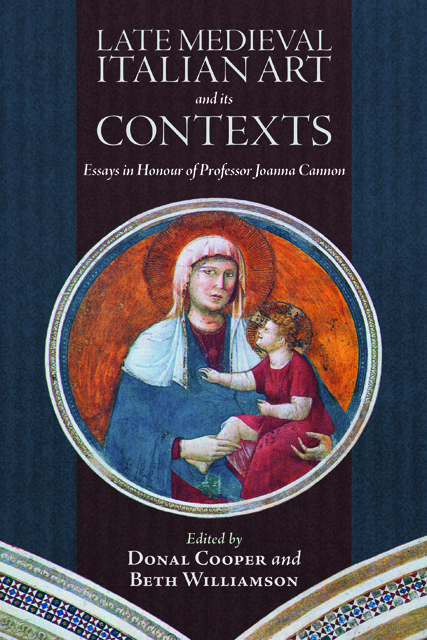Book contents
- Frontmatter
- Contents
- List of Illustrations
- List of Contributors
- Acknowledgements
- List of Abbreviations
- 1 Introduction: Circling Giotto
- 2 Holy Wood / ‘sacra tavola’: Saint Dominic and the Memory of Miracles in Bologna
- 3 The Sculpted Saint: A Statue of Saint Francis in Siena
- 4 Guccio di Mannaia and the Concept of a ‘Franciscan’ Chalice
- 5 ‘Speculum sine macula’: The Trittico di Santa Chiara in Trieste as an Object of Clarissan Devotion
- 6 The Siena Connection: A Franciscan Provincial Minister between Tuscany and Assisi at the Dawn of the Trecento
- 7 Simone Martini’s ‘Treaty with the House of Santa Fiora’ in Siena’s Palazzo Pubblico: Its Date and Significance
- 8 Crisis and Charity in Fourteenth-Century Florence: Ambrogio Lorenzetti’s Saint Nicholas Panels for San Procolo
- 9 Father of Light: Giotto and the Beatific Vision in the Baroncelli Chapel
- 10 Painter-Illuminator Workshops and the Church of San Giorgio a Ruballa: The Case of Bernardo Daddi and Pacino di Bonaguida
- 11 Patterns of Holiness: A Virgin Lactans in a Franciscan Context
- 12 A New Angle on Simone Martini’s Holy Family
- 13 Artistic Appropriation, Institutional Identity, and Civic Religion in Fourteenth-Century Siena: The Byzantine Treasury of the Hospital of Santa Maria della Scala
- 14 Visual Religious Education in Late Medieval Florence: Zanobi Perini, The Leggenda di Santo Tobia, and The Misericordia
- 15 Saints and Status in Late Medieval and Early Renaissance Florence
- Select Bibliography
- Publications by Joanna Cannon
- Index
- Tabula Gratulatoria
- Backmatter
12 - A New Angle on Simone Martini’s Holy Family
Published online by Cambridge University Press: 20 December 2022
- Frontmatter
- Contents
- List of Illustrations
- List of Contributors
- Acknowledgements
- List of Abbreviations
- 1 Introduction: Circling Giotto
- 2 Holy Wood / ‘sacra tavola’: Saint Dominic and the Memory of Miracles in Bologna
- 3 The Sculpted Saint: A Statue of Saint Francis in Siena
- 4 Guccio di Mannaia and the Concept of a ‘Franciscan’ Chalice
- 5 ‘Speculum sine macula’: The Trittico di Santa Chiara in Trieste as an Object of Clarissan Devotion
- 6 The Siena Connection: A Franciscan Provincial Minister between Tuscany and Assisi at the Dawn of the Trecento
- 7 Simone Martini’s ‘Treaty with the House of Santa Fiora’ in Siena’s Palazzo Pubblico: Its Date and Significance
- 8 Crisis and Charity in Fourteenth-Century Florence: Ambrogio Lorenzetti’s Saint Nicholas Panels for San Procolo
- 9 Father of Light: Giotto and the Beatific Vision in the Baroncelli Chapel
- 10 Painter-Illuminator Workshops and the Church of San Giorgio a Ruballa: The Case of Bernardo Daddi and Pacino di Bonaguida
- 11 Patterns of Holiness: A Virgin Lactans in a Franciscan Context
- 12 A New Angle on Simone Martini’s Holy Family
- 13 Artistic Appropriation, Institutional Identity, and Civic Religion in Fourteenth-Century Siena: The Byzantine Treasury of the Hospital of Santa Maria della Scala
- 14 Visual Religious Education in Late Medieval Florence: Zanobi Perini, The Leggenda di Santo Tobia, and The Misericordia
- 15 Saints and Status in Late Medieval and Early Renaissance Florence
- Select Bibliography
- Publications by Joanna Cannon
- Index
- Tabula Gratulatoria
- Backmatter
Summary
A longside a deep understanding of iconography, Joanna Cannon’s work has always privileged the close examination of objects with repeated attention to their original design, intended function, and subsequent use. The painted panel depicting Christ, Mary, and Joseph, signed by the Sienese painter Simone Martini in 1342 and now held in the Walker Art Gallery, Liverpool (Plate XVI) has proven an enigma that repays such repeated examination. Owing to the inscription FILII QUI[D] FECISTI N[OBIS SIC] finely painted on the Virgin’s open book, the biblical scene that the panel represents is one of its few certainties. Simone has visualised the following exchange of speech recorded in Luke’s Gospel between the twelve-year-old Christ and his parents in the Temple after he has been missing for three days:
… and his mother said unto him ‘Son, why hast thou thus dealt with us? Behold, thy father and I have sought thee, sorrowing.’
And he said unto them ‘How is it that you sought me? Did you not know I would be in my father’s house?’
And they understood not the saying which he spoke to them.
This fixes the narrative of the painting between the commonly depicted episode of Christ Disputing with the Doctors, and the lesser-represented Return of the Holy Family to Nazareth. What is remarkable about Simone’s painting is the manner in which he has dramatised the first recorded speech of Jesus Christ, not shying away from how he sternly rebuked his earthly parents. Simone’s depiction of a wholly unhappy Holy Family, arguably unique in the history of Christian art, suggests that it was an exceptional, bespoke commission for a particular client. This paper will synthesise the many theories that have been made about the textual sources and patronage of the Liverpool panel with an as-yet unremarked visual quirk in the painting. What will be interpreted as an intentional manipulation of the viewer’s gaze will be aligned with the playful approach to perception and cognition that characterised the more sophisticated examples of Trecento painting, confirming Simone’s enduring capacity for innovation in his artistic output.
- Type
- Chapter
- Information
- Late Medieval Italian Art and its ContextsEssays in Honour of Professor Joanna Cannon, pp. 229 - 248Publisher: Boydell & BrewerPrint publication year: 2022

